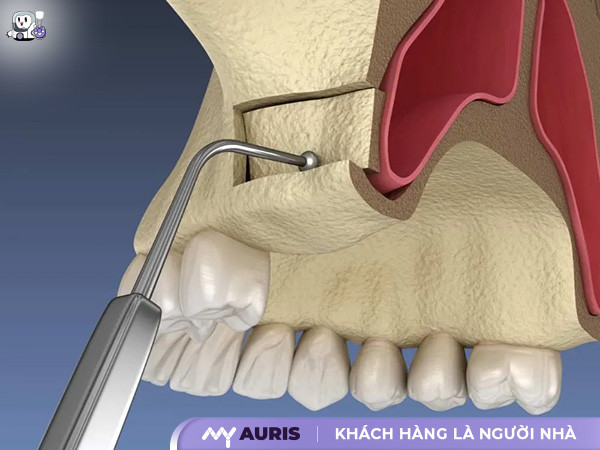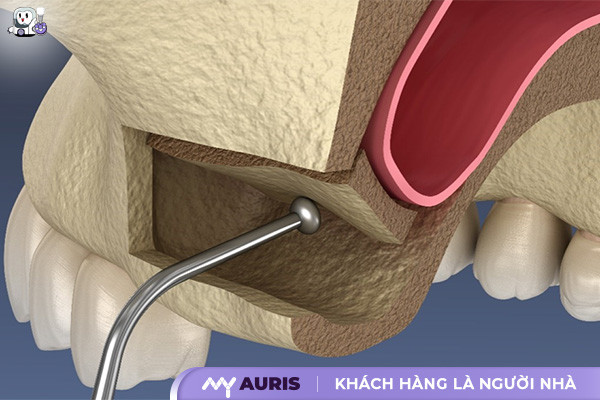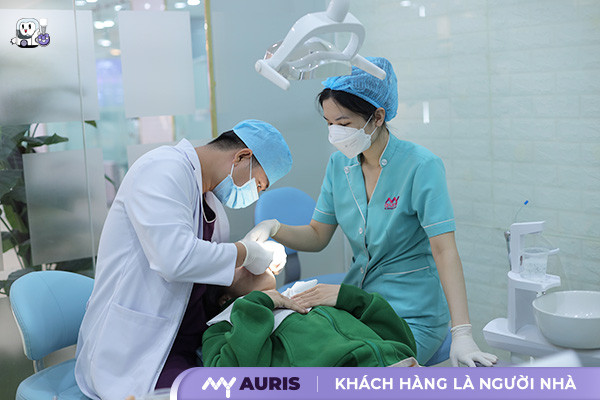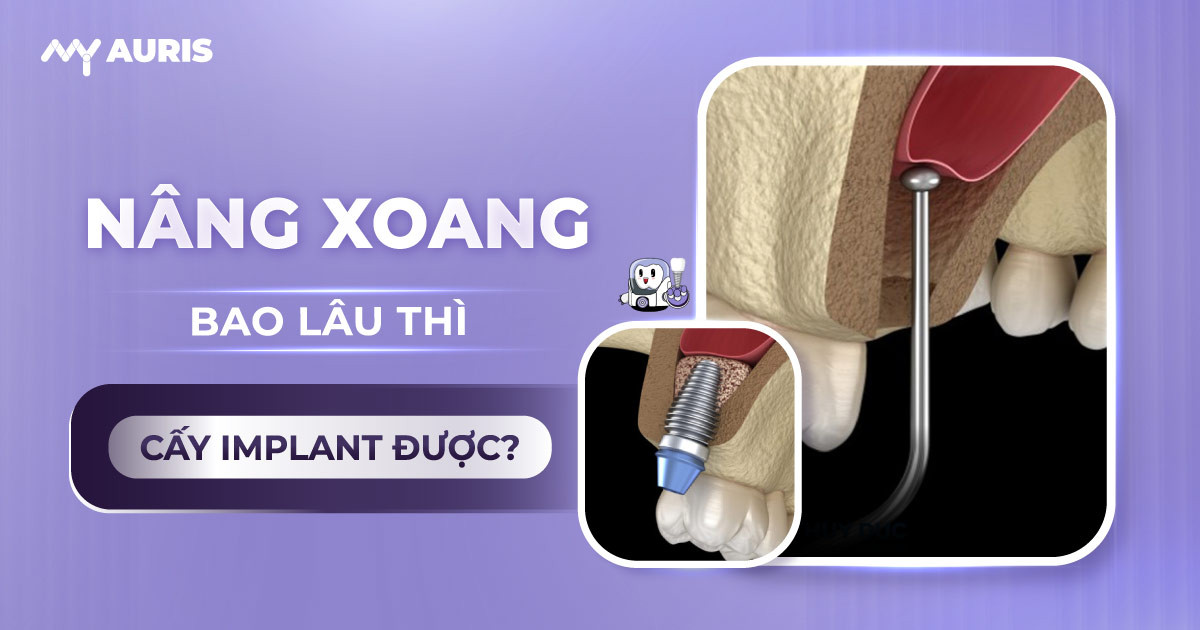When upper molars are lost for an extended period, the body tends to resorb the jawbone, leading to gradual degeneration of the maxillary sinus. Consequently, the sinus expands and lowers, approaching the crest of the upper jawbone. This results in insufficient bone height and density required for safe implant placement. In such situations, to ensure effective tooth restoration with implants, specialists often recommend sinus lift bone grafting during Implant placement. This method helps regenerate lost bone volume, creates a stable foundation for implant placement, and ensures the long-term stability of the dental restoration.
What is Closed Sinus Lift? How much does it cost?
What is a closed sinus lift? This is a sinus lift method performed internally through the implant osteotomy, requiring less surgery than traditional methods. In this technique, the dentist makes an incision on the gum to access the sinus area that needs to be lifted. Then, the dentist creates a small hole in the bone to gently elevate the sinus membrane, creating enough space for the bone graft material to be placed. The bone graft fills the space between the jawbone and the newly elevated sinus membrane, creating a solid foundation for future implant placement.
Characterized as a minimally invasive technique, a closed sinus lift helps reduce swelling and pain, shortens recovery time, and is often performed concurrently with implant placement to save treatment time.

Regarding the cost of a sinus lift, the price will vary depending on the policy of each dental clinic. Some providers may offer a package that includes both the sinus lift and the implant placement process, helping patients manage their budget more easily and feel more at ease during treatment.
Sinus Lift Bone Grafting Techniques in Implant Placement

Closed Sinus Lift in Implant Placement
A closed sinus lift is a bone grafting technique performed from inside the oral cavity, through the implant osteotomy. It does not require multiple surgeries, thus minimizing invasiveness and shortening recovery time. The dentist makes an incision on the gum in the sinus area that needs to be lifted, then creates a small hole in the bone to elevate the sinus membrane. The bone graft material is then placed to fill the space between the jawbone and the newly elevated sinus membrane, providing strong support for the implant post.
This method is minimally invasive, reduces swelling and pain, and is often performed simultaneously with implant placement, making it suitable for straightforward cases.
In cases of long-term upper molar loss, severe bone resorption often occurs, causing the maxillary sinus to lose bone support and descend. For effective dental implant placement, a sinus lift is mandatory to create space for the implant post.
If the upper sinus has not descended too far and the amount of bone supplementation required is not excessive, then a closed sinus lift is the appropriate method. Additionally, this technique is only applicable when:
- The sinus floor is not irregular or fibrously adhered
- The sinus membrane is not excessively thick and has no abnormalities
- There is no fluid in the sinus

Open Sinus Lift
The open sinus lift technique, also known as the lateral window sinus lift, is typically applied in more complex cases requiring deeper intervention. The dentist makes an incision in the gum next to the missing tooth, then adds bone graft material through this opening to elevate the sinus and create a stable foundation for implant placement.
This method is suitable for patients who have lost upper molars for an extended period, leading to severe jawbone resorption and jawbone degeneration, which causes the maxillary sinus to expand in volume and drop deep into the resorbed bone area.
The following cases cannot undergo a closed sinus lift due to the risk of affecting the sinus membrane:
- Significant bone deficiency
- Irregular or fibrously adhered sinus floor
- Thick sinus membrane with abnormalities
- Presence of fluid in the sinus
Under these conditions, the dentist will recommend an open sinus lift to ensure safety and long-term effectiveness during the sinus lift for implant placement.

Sinus Lift and Implant Placement Procedure at the Hospital
At reputable hospitals, the implant placement procedure combined with sinus lift and bone grafting is performed following a scientific protocol, ensuring the highest safety and effectiveness for patients. Below are the specific steps:
Day 1: General Examination and Personalized Treatment Plan
- A specialist examines the missing tooth condition, assesses the space available for implants, the state of the oral mucosa, any remaining root fragments, and chronic infection areas in the mouth that require thorough treatment.
- The patient undergoes Cone Beam CT scans to evaluate the edentulous area in 3D from multiple angles: bone quality, detection of inflammation requiring removal, assessment of the maxillary sinus condition, and jawbone height to plan appropriate sinus lift bone grafting for each patient.
- Next, plaster models of the dental arches are taken to aid in detailed planning, ensuring compatibility with individual chewing function and aesthetics.
- The dentist also inquires about the patient’s general health, checking for any existing medical conditions that might affect the surgical prognosis. In some cases, consultation with an internal medicine physician will be sought to evaluate medication issues and the feasibility of safe surgery.
Day 2: Sinus Lift Bone Grafting Surgery
- Based on the treatment plan, the patient undergoes sinus lift bone grafting surgery, ensuring a favorable biological environment for bone integration and preparing for future implant placement.
Day 3: Post-Surgery Follow-up and Re-examination
- After approximately 1 week, the patient will return for a follow-up appointment to have sutures removed. The dentist will monitor the healing process and promptly address any abnormal reactions (if present).
After 3 Months: Implant Placement and Restoration
- Once the bone tissue has healed stably after 3 months of recovery, the patient undergoes X-rays to assess the degree of integration between the native bone and the bone graft, and to check the condition of the maxillary sinus. If everything is stable, the dentist will proceed with implant placement as usual.
- In cases where an open sinus lift or a closed sinus lift combined with immediate implant placement was indicated, after 3 months, X-rays will also be taken to assess the degree of bone and implant integration. If the implant is well integrated, the dentist will expose the implant and proceed with the implant-supported restoration, fully restoring the patient’s chewing function and aesthetics.
Can Implants Be Placed Immediately After a Sinus Lift?
After a sinus lift, patients need to wait for the wound to fully heal, allowing for proper bone and tissue integration, and ensuring sufficient bone height before dental implants can be safely and effectively placed. Typically, implant placement occurs approximately 1 to 6 months later, depending on the degree of bone integration and individual healing capabilities.
However, in cases where conditions allow for immediate implant placement concurrently with a sinus lift and bone graft, the dentist may recommend performing these procedures simultaneously to shorten the overall treatment time. This depends on various factors such as the patient’s general health, bone quality, and tissue regeneration capacity.
Before making a decision, the dentist will conduct thorough examinations, X-rays, and discuss the specific timeline with the patient. Therefore, patients need not be overly concerned, as this process is always closely monitored and ensures absolute safety.
Potential Complications of Sinus Lift Surgery
During a sinus lift procedure, the main complication a patient might encounter is a perforation or tear of the sinus membrane – a situation that, while not common, carries potential risks. If this occurs, the dentist will suture the injured area. However, if the suturing is unsuccessful, the dentist will have to stop the treatment and advise the patient to wait for complete healing. After the recovery period, the patient will undergo a second sinus lift – at which point, the sinus membrane will be thicker and stronger, making the subsequent procedure safer and more effective.
Furthermore, infection is a risk in all surgical procedures, including sinus lifts. Although statistics show that sinus lifts rarely lead to infection, patients should not be complacent. Diligent wound care, combined with careful attention to diet and lifestyle after a sinus lift, are key factors determining the effectiveness and safety of the post-treatment outcome.
Special Considerations After Sinus Lift – Bone Grafting
Sinus lift – bone grafting is an advanced dental technique with a high degree of complexity, directly affecting the jawbone. Therefore, adhering to post-sinus lift and post-bone grafting instructions is crucial to ensure the safest and most effective recovery process.
Do not eat, chew, or spit for at least the first hour after surgery to avoid bleeding and impacting the fresh wound.
Within 24 hours after bone grafting, patients should limit movement, avoid strenuous activities, and instead get adequate rest to facilitate better bone integration.
In the first few days, patients can apply ice packs to reduce swelling and pain after bone grafting, combined with pain medication as prescribed by the dentist, to manage pain and inflammation.
Avoid areas with pressure changes such as scuba diving or flying, as pressure variations can affect the healing process.
Avoid strong impacts to the wound: absolutely do not poke or prod the wound. Also, avoid eating highly acidic foods as they can cause wound infection.
Given that this is a complex technique requiring high precision and expertise, choosing a reputable dental clinic with highly skilled dentists is a crucial factor for success. Prioritize facilities with standard sterilization systems, modern equipment, and clear procedures to ensure the safest and most effective execution of the technique.





